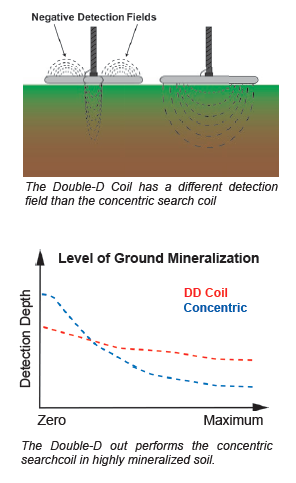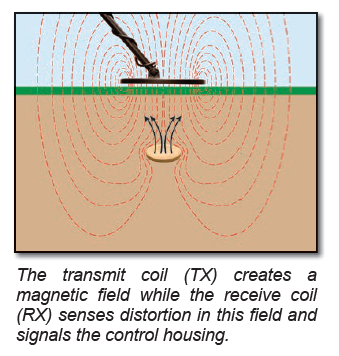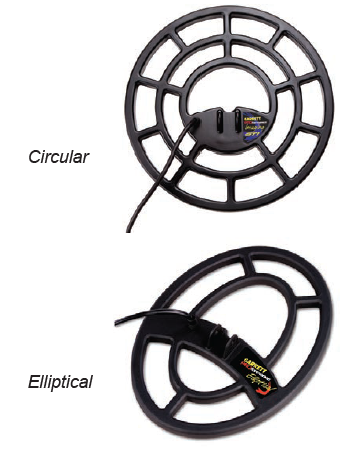There are a variety of searchcoil sizes and shapes and configurations. The correct one to use depends on the environment it will be used in as well as the targets being sought. A change in any one of these variables may require a different searchcoil. Sometimes changing the search coil on your metal detector is the next best thing to buying a whole new machine! It is possible that merely changing the coil on your detector will lead you to a host of new targets.
used in as well as the targets being sought. A change in any one of these variables may require a different searchcoil. Sometimes changing the search coil on your metal detector is the next best thing to buying a whole new machine! It is possible that merely changing the coil on your detector will lead you to a host of new targets.
CONFIGURATIONS
In addition to searchcoil sizes and shapes, there are also a variety of searchcoil configurations available, with each proving to be the best choice depending on hunting applications and ground conditions. The configuration of a searchcoil refers to the arrangement of the Transmit Coil (TX) and Receive Coil (RX) within the searchcoil shell. The most common configurations are: Concentric, Mono, Imaging, and Double-D.
Concentric
The concentric configuration consists of a TX coil and RX coil which are usually circular. The advantage of this configuration is that both the TX and RX coils are wound as large as possible within a given searchcoil diameter. This provides the largest possible detection fi eld and greatest detection depth, making the concentric coil potentially the most sensitive confi guration available. In addition, concentric coils also provide the most symmetrical detection field, allowing ease in pinpointing and consistency in target identification. For these reasons, they are the most commonly used searchcoil and will provide the best overall performance in most environments. Unfortunately, this configuration is the most susceptible to interference from ground minerals, which results in substantial loss of performance when used over heavily mineralized ground.
Mono
A mono-coil is available only on Pulse Induction detectors, such as Garrett's new Axiom Metal Detector, and is a variation of the concentric configuration. The mono-coil can be manufactured with the TX and RX coils located together or as a single coil acting as both TX and RX. The detection and performance characteristics of the mono are essentially the same as the concentric in that it provides the maximum possible sensitivity, but suffers some performance in mineralized ground.
Imaging
An Imaging searchcoil is an enhanced version of the concentric configuration that features an additional RX coil. This extra coil provides the detector with additional target information necessary for true target-depth perception and true target-sizing capabilities. With this additional sizing information, the detector can more fully characterize a target and for the first time distinguish between trash and good targets of the same conductivity (e.g. a quarter vs. a soda can). Only the Garrett GTI metal detector offers this technology.
DD Search coils have two smaller “D” shaped coils housed inside to penetrate heavily mineralized ground that is commonly encountered while gold prospecting and relic hunting. The Double-D configuration is designed to  significantly reduce ground interference and, thereby, recover the performance lost by a concentric coil over mineralized soil. With the Double-D, it is the arrangement of the TX and RX coils that produce a canceling effect of ground signals. This configuration is called DD because both TX and RX coils are in the shape of a “D”. The positive detection fi eld of the DD runs beneath the overlapping center section from front-to-back. The remaining portion of the coil actually produces negative (i.e. canceling) detection fields. It is this canceling field that allows the DD coil to maintain performance over mineralized ground. Because of its small positive detection field, the DD is inherently less sensitive than a concentric searchcoil of the same size, over non-mineralized ground. The Double-D will, however, significantly outperform the concentric coil over mineralized ground. For this reason, it is highly recommended when hunting over mineralized ground commonly found when prospecting and relic hunting.
significantly reduce ground interference and, thereby, recover the performance lost by a concentric coil over mineralized soil. With the Double-D, it is the arrangement of the TX and RX coils that produce a canceling effect of ground signals. This configuration is called DD because both TX and RX coils are in the shape of a “D”. The positive detection fi eld of the DD runs beneath the overlapping center section from front-to-back. The remaining portion of the coil actually produces negative (i.e. canceling) detection fields. It is this canceling field that allows the DD coil to maintain performance over mineralized ground. Because of its small positive detection field, the DD is inherently less sensitive than a concentric searchcoil of the same size, over non-mineralized ground. The Double-D will, however, significantly outperform the concentric coil over mineralized ground. For this reason, it is highly recommended when hunting over mineralized ground commonly found when prospecting and relic hunting.
It’s important to know the benefits of using various size, shape and configurations of coils because simply changing the search coil on your metal detector is the next best thing to buying a whole new machine! Garrett is the global leader of ground search metal detectors, pinpoints, coils, and other accessories. Browse Garrett detectors and more.
Part 1 covered search coil size, shape and depth.






 used in as well as the targets being sought. A change in any one of these variables may require a different searchcoil. Sometimes changing the search coil on your metal detector is the next best thing to buying a whole new machine! It is possible that merely changing the coil on your detector will lead you to a host of new targets.
used in as well as the targets being sought. A change in any one of these variables may require a different searchcoil. Sometimes changing the search coil on your metal detector is the next best thing to buying a whole new machine! It is possible that merely changing the coil on your detector will lead you to a host of new targets. significantly reduce ground interference and, thereby, recover the performance lost by a concentric coil over mineralized soil. With the Double-D, it is the arrangement of the TX and RX coils that produce a canceling effect of ground signals. This configuration is called DD because both TX and RX coils are in the shape of a “D”. The positive detection fi eld of the DD runs beneath the overlapping center section from front-to-back. The remaining portion of the coil actually produces negative (i.e. canceling) detection fields. It is this canceling field that allows the DD coil to maintain performance over mineralized ground. Because of its small positive detection field, the DD is inherently less sensitive than a concentric searchcoil of the same size, over non-mineralized ground. The Double-D will, however, significantly outperform the concentric coil over mineralized ground. For this reason, it is highly recommended when hunting over mineralized ground commonly found when prospecting and relic hunting.
significantly reduce ground interference and, thereby, recover the performance lost by a concentric coil over mineralized soil. With the Double-D, it is the arrangement of the TX and RX coils that produce a canceling effect of ground signals. This configuration is called DD because both TX and RX coils are in the shape of a “D”. The positive detection fi eld of the DD runs beneath the overlapping center section from front-to-back. The remaining portion of the coil actually produces negative (i.e. canceling) detection fields. It is this canceling field that allows the DD coil to maintain performance over mineralized ground. Because of its small positive detection field, the DD is inherently less sensitive than a concentric searchcoil of the same size, over non-mineralized ground. The Double-D will, however, significantly outperform the concentric coil over mineralized ground. For this reason, it is highly recommended when hunting over mineralized ground commonly found when prospecting and relic hunting.
